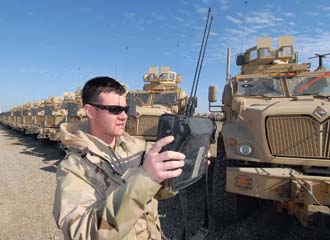Origins of Technology Materials Gain Importance
 |
Paul Vanluvender, an electronics integrated systems mechanic, performs operational verification of electronics systems on a mine resistant ambush protected vehicle in Southwest Asia. Expected U.S. Securities and Exchange Commission regulations regarding the reporting of conflict minerals will have a large impact on electronics manufacturers as well as the developers and users of systems containing electronic components. |
The electronics firms that are leading the information revolution now are facing the challenge of ensuring that their products have no taint of war. Many high-technology manufacturing companies are beginning to tailor their policies to meet expected formal guidelines on where they can obtain vital minerals and metals that are essential to their advanced products. Soon, these groups should know exactly what steps they must take to show that their material supply chains of what are being described as “conflict minerals” do not fund violence in the Democratic Republic of the Congo.
The U.S. Securities and Exchange Commission (SEC) is scheduled to release its final rule regarding the need for manufacturers to divulge this information no later than next month; the original deadline was April 2011. SEC statements say staff members are working to adopt effective rules as quickly as they can while ensuring that final results are the right answer to the problem.
Attention on conflict minerals intensified with the signing into law of the Dodd-Frank Wall Street Reform and Consumer Protection Act in 2010. Section 1502 of the law amends Section 13 of the Securities Exchange Act of 1934, mandating that persons who require columbite-tantalite (coltan), cassiterite, gold, wolframite or their derivatives to build their products report annually regarding where they obtained the materials. Derivatives include metals such as tantalum, tin and tungsten, all common in the electronics industry—the business sector that may be most affected by any regulations.
Organizations that use electronics in their products—including the avionics and automotive industries as well as government developers—also will be affected. In the law, the definition of conflict minerals further extends to those determined by the secretary of state to finance conflict in the Congo or an adjoining country.
Even as companies prepare for the ramifications at the federal level, they also must pay attention to state legislatures that are starting to pass their own laws about who can do business with agencies within their borders. Last year, California became the first state to enact a law prohibiting state agencies from contracting with companies that are in violation of reporting in compliance with the Dodd-Frank mandates. Other states, such as Massachusetts and Maryland, also have conflict-mineral bills in the works.
According to the SEC, Section 1502 mandates that persons “disclose annually whether any conflict minerals that are necessary to the functionality or production of a product of the person, as defined in the provision, originated in the Democratic Republic of the Congo or an adjoining country and, if so, to provide a report describing, among other matters, the measures taken to exercise due diligence on the source and chain of custody of those minerals, which must include an independent private sector audit of the report that is certified by the person filing the report.”
The upcoming rule will apply to issuers who file reports with the SEC under Exchange Act sections 13(a) or 15(d) who need conflict minerals for the functionality or production of products or who are “contracted to be manufactured by such issuer.” It mandates several reporting requirements at different levels regarding where and how companies must disclose their conflict minerals sources.
The overall issue stems from reports that violence in the Congo, especially sexual and gender-based violence, is funded by the sale of these minerals. War also surrounds maintaining control of the mines. The U.S. State Department and organizations focused on the beleaguered African nation have applauded the legislation, and many electronics companies already have issued statements that they will not use minerals that help fund atrocities. Motorola Solutions Incorporated founded Solutions for Hope, a pilot initiative to source conflict-free tantalum. Participants include Nokia, Intel Corporation and Hewlett-Packard. Other major manufacturers have announced their own commitments to find alternative sources for necessary minerals.
The Organization for Economic Cooperation and Development’s |
| 1. Establish strong company management systems. |
| 2. Identify and assess risk in the supply chain. |
| 3. Design and implement a strategy to respond to identified risks. |
| 4. Carry out independent third-party audit of supply chain due diligence at identified points in the supply chain. |
| 5. Report on supply chain due diligence. |
From: OECD (2011), OECD Due Diligence Guidance for Responsible Supply Chains of Minerals from Conflict-Affected and High-Risk Areas, OECD Publishing. http://dx.doi.org/ 10.1787/9789264111110-en) |
Though the law was passed in the U.S. Congress and will be enforced by the U.S. government, it has wider ramifications. Foreign companies using the types of minerals covered by the legislation that want to work with U.S. organizations must be prepared for questions regarding their sourcing. The SEC’s proposed rule on conflict minerals states that it does not plan to exempt foreign issuers, but it asks for comments on the provision.
The State Department has worked with U.S. and international businesses to implement due-diligence practices, and the agency strongly supports the guidance issued by the Organization for Economic Cooperation and Development. Department personnel encourage companies to draw upon this guidance, which has at its core a five-step framework. A State Department official explains that Section 1502 represents an important element of a wide range of efforts undertaken by the United States and the international community to stop the illicit trade in conflict minerals and that the agency is looking forward to the issuance of the final regulations implementing that provision of law.
Critics of the Dodd-Frank Act’s conflict-mineral section worry it will hamper other more meaningful economic changes in the area and that an embargo across the board in the region potentially will prevent those legitimately working in smelters and mines from making a living. In addition, complying with the provisions could be both costly and difficult. To perform due diligence, companies have to track down what smelters refined their minerals, and the smelters have to know where they acquired the materials. In the Congo and other war-torn regions, records and tracking can be sketchy or nonexistent.
Michael Bierkandt, a technical expert on supply-chain compliance and an employee of iPoint-systems Incorporated, a German company that makes a compliance software suite, says some estimates put the cost of compliance at around $8 billion. Half will be the cost to personnel in the companies dealing with the issues, and half will be for system audits and other outside activities. According to these estimates, more than 12 million companies worldwide could be affected. “Those are quite some numbers,” Bierkandt says.
Cost and time requirements to comply especially could burden small businesses. William Newman, managing principal of Newport Consulting Group, and a reference for many top companies looking to best position their sustainability products and initiatives, says, “You want to make sure that’s not cost prohibitive. You want reporting that is adequate and appropriate for each level of the supply chain.”
Another problem for businesses stems from finding alternative sources of the minerals. Newman explains that the Congo “is where a significant source of the world’s minerals used in the semiconductor and high-tech industries are coming from. There’s really not much one can do on this issue unless all of a sudden we discover another source of natural resources.”
While companies remain in limbo waiting to learn about reporting specifics and the consequences of not complying, the problem of bad publicity generated from the purchase of conflict materials could have the greatest effect on the bottom line. Newman says that in the product-compliance space market response to brand has been the biggest impact on companies dealing with various health, safety or social-responsibility regulations. “It’s really on brand, market share and consumer preferences,” he states. “You can even take that into the military space. Buyers are people too. They want to make sure they’re protecting their brand of government.”
Newman and Bierkandt both say that the officials of many companies with whom they discuss the issue are in a wait-and-see situation until the SEC issues the formal regulations. Such situations are not unique. The Environmental Protection Agency, for example, has delayed releasing regulations on environmental concerns—many of which are expected to have stringent reporting requirements—causing uncertainty for those who might have to change operations.
Bierkandt has suggestions for organizations that want to start addressing conflict minerals for legal or conscience reasons. “The first thing is companies have to know what is in their products,” he says. This entails talking to suppliers, examining data and understanding where or if problems exist. “This should be a software-based approach,” Bierkandt says, because it will make tracking and reporting less of a burden.
In the future, portals that allow members of a supply chain to report into a larger organization’s environment could become more common. This practice not only helps identity conflict-free minerals and smelters, but also assists in complying with other laws that affect business. Bierkandt believes that solutions should share more than one type of information. “We need a general exchange point where you can transfer all this data between the companies,” he states.
Newman says that proactive manufacturers are developing or employing platforms that can incorporate data for more than one standard. Such technology likely will increase in usefulness. “This is not the end,” Newman explains. “This is only going to continue as political, environmental and social pressures increase. It’s going to be almost mandatory for companies to have easy-to-use, consolidated windows into their product materials and even where those minerals that make those substances come from.”
WEB RESOURCES
Proposed SEC Conflict Minerals Rule: www.sec.gov/rules/proposed/2010/34-63547.pdf
Dodd-Frank Act: www.gpo.gov/fdsys/pkg/BILLS-111hr4173enr/pdf/BILLS-111hr4173enr.pdf
Securities Exchange Act of 1934: www.sec.gov/about/laws/sea34.pdf
OECD Due Diligence Guidance: www.oecd.org/dataoecd/62/30/46740847.pdf




Comments